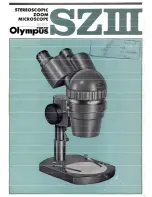
6
FOCUSING PROCEDURE
The whole point of stereoscopic microscopes is that, when properly adjusted, the observer sees the object
image in three dimensions and can perceive height and depths on the specimen. This is a great advantage
in material examination and quality control techniques.
To achieve these desirable height/depth effects the images coming from the binocular eyepieces must be
"fused" into a single image by the observer - this requires some practice and careful setting of the binocular
body. Procedure is as follows:-
The operator should move eyepiece tubes in and out to find the place where the distance between
eyepiece centers matches the distance between the pupils of his own eyes. This is the
interpupillary
distance
and will vary somewhat from operator to operator. When these distances are equal (or
match
),
one central image is seen by the operator.
54-74mm
"Fused"
When replacing stage plate loosen the set screw
which is visible infront of the stage.
Stage plate set screw
Black and White
Stage Plate
The Rigid arm type focusing stands (except the
model ABE) have a focusing capability only by
rack and pinion adjustment. This means that the
available range of specimen sizes/depths which
can be accommodated is somewhat less than in
the case of Pole-type stands.
The Rigid arm type ABE focusing stand is with
integral focus block and extendable working
distance. Provides transmitted and incident
halogen illumination.
To extend working distance,
loosen the clamp screw and
extend the arm upward and
set the screw back.
AZ, ABZ and ABZH
stands are rigid arm type
focusing stands.
Focusing Screw
Clamp Screw
ABE Extendable
PRECISE FOCUS ON SPECIMEN
Stage Plates
You should now decide which of the stage plates supplied will be most suitable.
The focusing stands with plain bases, P, PL, PX, PC and A, are supplied with reversible black and white
stage plates. Your selection depends on which side, black or white, gives the best contrast conditions with
your selected specimen.
The focusing stands with transmitted illuminators, PB, PBH, ABZ, ABZH and ABE, are supplied with clear
glass stage plates and reversible black and white stage plates. If the specimen is semi-transparent, the
glass stage plate shoud be used with transmitted illumination switched on. If the specimen is opaque, use
the black/white stage. Your selection depends on which side,
black and white, gives the best contrast.

































